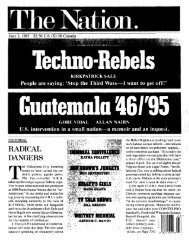Divergent Trajectories: Healthcare Insurance Reforms in East Asia ...
Divergent Trajectories: Healthcare Insurance Reforms in East Asia ...
Divergent Trajectories: Healthcare Insurance Reforms in East Asia ...
Create successful ePaper yourself
Turn your PDF publications into a flip-book with our unique Google optimized e-Paper software.
Illan Nam, Colgate University, Feb 2011Draft <strong>in</strong> progress, please do not quote or citewill<strong>in</strong>gness to subsidize lower-<strong>in</strong>come workers through a more redistributive program.This change <strong>in</strong> perception, especially among white-collar formal sector workers, waspivotal <strong>in</strong> spawn<strong>in</strong>g the formation of a broad cross-class coalition between labororganizations and more “middle-class”-based civil society groups that generated supportfrom both white-collar and work<strong>in</strong>g class voters for a more solidaristic s<strong>in</strong>gle-payer fund.In contrast, <strong>in</strong> countries that were plagued by higher <strong>in</strong>equality, I argue that the<strong>in</strong>crease <strong>in</strong> labor market <strong>in</strong>security did not generate as much of a perception of sharedrisks between formal and <strong>in</strong>formal sector workers. In these countries, workers across allsegments also experienced grow<strong>in</strong>g precariousness dur<strong>in</strong>g the 1990s. Labor marketsurveys reveal that labor market flexibilization affected all classes of workers – fromunskilled and skilled manual labor to white-collar workers; across all segments, moreworkers were hired on short-term or fixed-term (honorario) as opposed to open-endedcontracts, which heightened employment <strong>in</strong>stability and correspond<strong>in</strong>gly, the risk ofbe<strong>in</strong>g unable to afford healthcare <strong>in</strong>surance or be<strong>in</strong>g bumped out of company-based<strong>in</strong>surance pools. But despite the growth <strong>in</strong> <strong>in</strong>security, workers – blue-collar and whitecollarrema<strong>in</strong>ed atomized and virtually no cross-class coalitions of grassrootsorganizations emerged. While many have argued that the paucity of grassrootsmobilization was rooted <strong>in</strong> neoliberal labor market policies (most prom<strong>in</strong>ently, thedismantl<strong>in</strong>g of the public sector and the dim<strong>in</strong>ution of labor unions), fund<strong>in</strong>g constra<strong>in</strong>tsfor NGOs <strong>in</strong> Lat<strong>in</strong> America, and the decimation of grassroots organizations dur<strong>in</strong>g theauthoritarian periods, an alternative explanation for the absence of cross-classmobilization may lie <strong>in</strong> the barriers posed by high levels of <strong>in</strong>equality. Even whenupscale and downscale workers faced some measure of shared <strong>in</strong>security, the chasm that28













